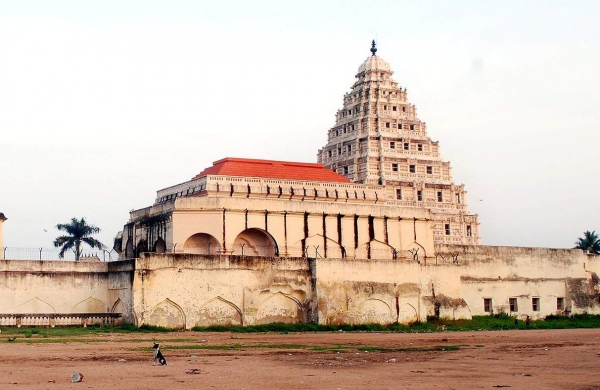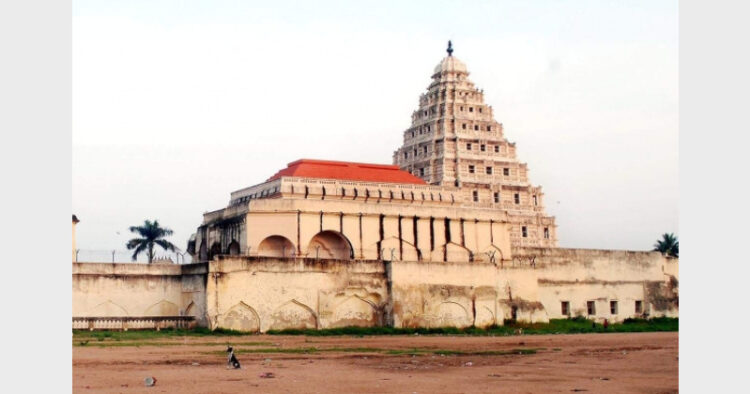
1
In Thanjavur, while digging for the Smart City project, workers found a Chola era linear wall which is said to be centuries old. Heritage enthusiasts are demanding immediate stopping of the construction work.
Thanjavur Corporation had embarked on a modern commercial complex project at a cost of Rs.43.6 crore on South Rampart Street, six months ago after pulling down the old Thiruvalluvar theatre-cum-commercial complex. This lies 100 meters from Big Temple. Workers were digging earth near old Thiruvalluvar theatre parking bay. The big temple is maintained by ASI and no approval is normally given to undertake any construction or digging in the vicinity of such heritage monuments. But in gross violation of norms, digging was done as part of the smart city project. While digging the earth, workers found layers of red soil and brickwork structures. The linear walk that surfaced in the southern boundary of the site is believed to of a Chola-era one. It is about 700 meters from Peruvudaiyar temple, a UNESCO world heritage site.
The wall which was about 50 meters long is visible at about 10 feet from the ground level abutting the backyards of commercial establishments on Raja Mirasudar Hospital road. The structure appears to have multiple decks including two layers of stones. Locals believe that after independence, due to ignorance the moat must have encroached and buildings were raised on it. It could be a Chola era palace. Dr S.Udhaya Shankar (president of Great Cholas historical research group) and Andavar Kani said after digging up the earth, we could see 8th and 9th-century basements over the red granite rocks in that area. This might be the outer fort wall of the moat build during the imperial Chola era.
Petitions were given last year to ASI seeking its nod to carry out excavations. It is still pending. The current digging work will affect the moat around the temple. “We have not made a formal request to District collector, ASI and other departments to stop forthwith the digging work. Also to Singapore based NGO, India Pride, which is working for the retrieval of stolen rare idols of Indian temples and Ministers in this regard. We have requested to carry out due research to find out if there are any buried structures underneath” Udhaya Shankar said. He also added, “We want the site to be handed over to the ASI for excavation and research.” He said that as per the norms and guidelines for the preservation from the ASI department which was not done in this case. Heritage lovers demand proper research of the area be done by the ASI. “The digging was being carried with heavy machinery. The entire Thanjavur fort area is a heritage zone. So there should not be any new construction. Restoration and preservation are only permitted and the construction work may even affect the Big temple”, he warned.
Locals say the smart city need not stand on the ruins of Bharat’s rich heritage which the main identity of Thanjavur city. Historians say a rare variety of red granite stones were used for the basement of the temple which should not be damaged by the digging and construction activities. They say as per the ASI regulations, no digging or construction is permitted within 100 meters of any heritage structure. The city was capital of Chola kings and so far no scientific or systematic study or excavation was done. It is learnt that the ASI has sent notices to Commissioner of Thanjavur Municipal Corporation asking them to stop the work.
2
Madras High Court on 25th January ordered the ASI and the state Archaeology department to inspect and submit a report on public interest litigation (PIL). The petitioner, S Kamaraj aka Muthalankurichi Kamaraj, who writes on history, archaeology and temples, sought a direction to authorities to carry out archaeological excavation at Ulakudi village in Thoothukudi district and to declare it a protected site. He said menhirs, which is also known as sanding stones for graves, cairns, stone circles, ruins of iron smelter workshop were found near a hill. A lot of research papers were done in the village. The standing stone which is found in the village is 13 ft tall with artwork on the side might date back to the megalithic age. Standing stones are erected in commemoration of heroes who died in the war. A division bench of Justice M M Sundresh and Justice S Ananthi, after perusal of the photographs produced by the petitioner, said it may be a megalithic stone.
An ancient Ranganathaswamy temple granary in Adhi Thiruvarangam at Villupuram needs immediate attention. The yesteryear kings built granaries in temples to save grains to be used in lean or drought times. Such granaries can be seen in Srirangam Ranganathar, Thiruvanaikaval Jumblingam, Thanjavur Thirupalaivala natar temple and Villupuram Ranganathaswamy temple. In Adirangam or uthararangam, the deity is in reclining posture which is made of herbs. The main deity is bigger than the Sri Rangam Ranganathar. The granary was built during the Vijayanagar King period to store the paddy from the fields of the temple. Inscriptions in the temple say grants were given by the Vijayanagar kings for the renovation of the temple tank and lands for temple employees. Failure of proper maintenance, the granary is a poor condition which needs immediate attention of authorities. Plants and mould are seen over the structure. The roots of vegetation may destroy the granary further. This has been brought to the notice of the HR and CE department.
3
In a slightly elevated land, a team of Pandiya Nadu Cultural Foundation led by archaeologist D Muneeswaran has discovered two abandoned 16th-century hero stones at Moolipatti near Chenkundrapuram in Virudhunagar district recently. He said “one of the hero stones is 3 feet tall and 1.5 feet wide with a horse-mounted soldier. The other is that of a soldier holding a sharp weapon ( 2 ft height and one foot wide). It was under the Chieftain administration in those days. Very few hero stones are worshipped as deities to this day for their valour. It stopped during the British raj”.
A team of Tirupur based Virarajendran Archaeological and Historical Research Centre has found two 13th century and one 17th century hero stones at Vinnamppallai village in Erode district. Its leader S Ravikumar said “two of the three hero stones were unique. While most of the stone found in Tamil Nadu show fight between a warrior and a tiger. But here one of the stones found to show a fight between two tigers and a warrior. Two of his dogs were seen helping in his fight with the big cat behind him. His dressing style and hairstyle could be dated back to at least 800 years old”.
From the 14th century stone inscription found near Thodi in Ramanathapuram district, we could know a temple deity called Puravuvari ( mean land tax) Vinnakara Peruvian. V Rajaguru, president, Ramanathapuram archaeological research foundation said that the stone inscription dating back to 1329 when renovation work was taken up in the sanctum sanctorum of garudazhvar in the Uthipootha Perumal temple in Thondi. He said of the 35 lined inscription, the first and the last were damaged due to wear and tear. It was carved during the 15th regnal year of Sri Parakrama Pandiyan, who ruled between 1315 and 1334. It says Thiruvarangarayan from Malai Mandalam had gifted money to buy a piece of land in Sathi Yeri village for daily pooja of this temple. The land was declared tax free as it was gifted to temple. Currently, there is no village called Sathi Yeri. Another inscription found in the district to mention about the village. The temple is now called Unthipootha Perumal. But it was referred to as Thirumerkovil and the main deity is Puravuvari Vinnakkara Peruvayan in the stone inscription”.
4
A rare 5,000-year-old Maragatha (Emerald) Lingam was found at Mungappattu village near Guidiyattam in Vellore district while digging land to build a Sanctorum for a temple. On the way to Meenur hill, there is a Hanuman temple, villager sited a ruined temple in midst of bushes. They decided to renovate and rebuild the temple. While digging the sanctum Santorum of the temple, they found a believed to be 3,000 to 5,000 years old Maragatha Lingam weighing 400 kg. The aavudaiyar ( base ) is in square shape against a normal round base. The lingam was now housed in a temporary pedestal and poojas are being done daily. People from Perumbadi, Mungappattu, Sabri Nagar, Mullai Nagar, Kannigapuram Agraharam and other surrounding places throng the temple to have a darshan of Lord Shiva.
The villagers also found a wall inscribed with a King sitting on a horse holding bow and sword and pictures of soldiers fighting with spears. They are seen in a damaged condition. Barely 30 ft from the temple, there was found an old pond beside a mausoleum of a King. The pillars in the temple look like an ancient architecture. History enthusiastic Perumbadi Kannapiran said the Maragatha lingam with square shape base which belonged to ancient times. During the Chola period, Shiva lingams have circular bases. There is evidence for a kingdom in that area. They request the ASI to do excavation to find out the ancient kingdom.
In Cuddalore District at Srimushnam, Muslims encroached the temple lands and do not allow Hindus to worship at the Siva temple. Muslims claim right for the Palayamkottai, an ancient Siva temple as their property. Hindus have petitioned the police. But the police support the Muslims and take action against the Hindus by arresting them. The Muslims claims rights for hanuman temple at the Sakkli Kunde pond area. Locals say both temple sites belong to Hindu temples. But the Muslims do not allow them to pray and visit the temple. Police are partial and take side with them. In fact, the land in which they have built properties are belonging to temple lands. “The temple has over 60 acres of land which are in a lease with Muslims. We have evidence to prove the property is ours”, said a villager.














Comments